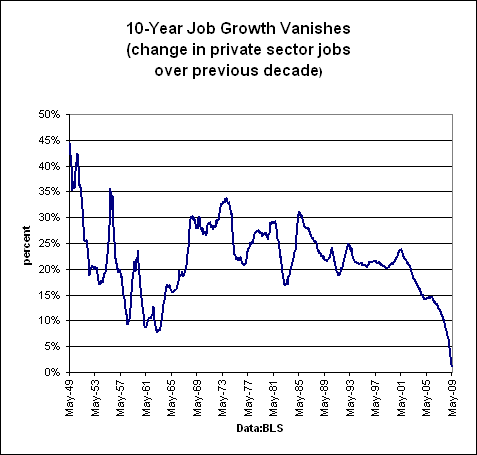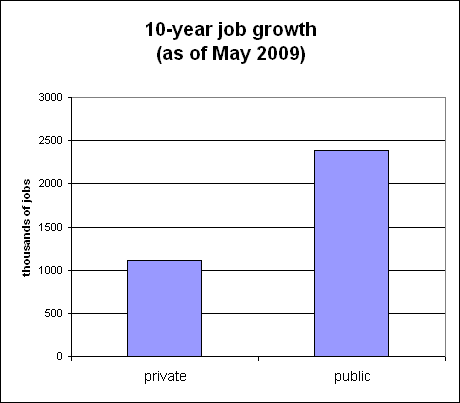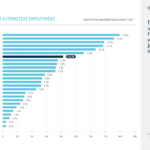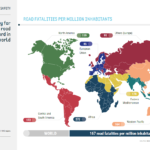Back in June, Michael Mandel of Business Week wrote an interesting piece titled A Lost Decade for Jobs in which he analyzed the growth Private Vs. Public sector job growth. His research showed that the private sector “job growth was almost non-existent over the past ten years”.
He added “Between May 1999 and May 2009, employment in the private sector sector only rose by 1.1%, by far the lowest 10-year increase in the post-depression period.
It’s impossible to overstate how bad this is. Basically speaking, the private sector job machine has almost completely stalled over the past ten years.”
Source:Â Economics Unbound, Business Week
“Over the past 10 years, the private sector has generated roughly 1.1 million additional jobs, or about 100K per year. The public sector created about 2.4 million jobs.
But even that gives the private sector too much credit. Remember that the private sector includes health care, social assistance, and education, all areas which receive a lot of government support.”
So for the past 10 years private sector job growth was just 100K per year which is very minuscule for an economy of our size. I wanted to see how this compares with the growth of population in our country especially due to immigration. In the post I shall try to analyze some of the effects of job growth against high growth in immigrants intake.
According to Office of Immigration Statistics, a total of 1,107,126 persons became Legal Permanent Residents (LPRs) or Green Card holders of the United States in 2008. 58% of them already lived here. The following chart shows the growth of LPR from 1900 to 2008 into the U.S.:
Source: Annual Flow Report, March 2009
Office of Immigration Statistics, Department of Homeland Security
The above chart shows that immigration growth increased from 2000.The Annual Flow Report stated “The annual LPR flow has exhibited an upward trend since World War II . The annual average LPR flow quadrupled from 250,000 during the 1950s to just over one million during 2000 to 2008.”
When the private sector created 100K jobs between May 1999 and May 2009, the annual issue of LPRs averaged 1 Million per year from 2000 to 2008. Both the private and public sector combined created 3.5 new jobs in the past decade. This is simply far less than the 10 million immigrants admitted to the country. It must be noted that not all of the one million LPRs issued are working age adults. Some of them may have been here already with jobs when they became permanent residents. Overall more immigrants came into the country during the decade when the private sector job growth was almost non-existent. We must also remember that the above statistics do not reflect the flow of illegals that entered the country during the period discussed which could also be in the millions in a decade.
The following table shows the yearly growth of Legal Permanent Residents into the U.S. from 1997 thru 2007:
[TABLE=172]
Source: U.S. Department of Homeland Security, Office of Immigration Statistics, 2007 Yearbook of Immigration StatisticsÂ
During the past two decades millions of jobs have disappeared in the US as those jobs were exported to low-wage countries such as Mexico, China, India, Vietnam, etc. Manufacturing was hard hit as literally thousands of factories were shutdown and moved to overseas locations as part of NAFTA and globalization. Entire towns in the midwest were decimated and became “rust-belt” towns overnight because of this phenomenon.
In addition to the granting of legal permanent residency status, the U.S. also allows thousands of workers into the country under different categories of visas. One of the most popular category is the controversial H1B visa which “allows U.S. employers to temporarily employ foreign workers in specialty occupations” per Wikipedia. This visa is granted for a maximum of six years. Currently a total 65,000 per year can be issue in this category. Due to high economic growth the limit was increased to 195,000 in 2001, 2002 and 2003.
In the past, the entire total of such visas for a year was exhausted in just a few weeks as the demand for them was extremely high among aliens wanting to work here. However the demand is falling in recent months due to high unemployment and the recession as many of the workers realize that their chances are of finding a job are better in their home countries than in the U.S.. The Top 10 users of the H1B visas are the IT outsourcing firms from India. Some of high-paying IT jobs that were not off-shored to other countries went to folks on H1B visas since they could be hired at wages much lower than the wages demanded by a US citizen.This H1B visa program probably exacerbated the unemployment situation. example, 195K visas were issued in 2001 when only 100K private sector jobs were created.
In response to the current recession, some countries have announced plans to reduce the number of immigrants allowed into the country. Australia has announced “a 14 per cent cut to the skilled migration program, capping the number of workers to enter Australia next year at 115,000, down from 133,500 in 2008-09”. Despite having high unemployment levels, Canada did not reduce the number of immigrants allowed into the country for this year. Many have questioned this decision by the Canadian government. Because the Canadian economy is highly dependent on the US, jobs growth in Canada will be non-existent until the economy improves south of the border.
The U.K. has also announced that immigration will be cut as the unemployment levels soar. From an article in The Times: “Phil Woolas, in his first interview since taking over as Immigration Minister, said that he wanted to see a dramatic reduction in the number of migrants coming to Britain.
In what many will see as extraordinary remarks for a Labour minister, he told The Times that the economic backdrop changed everything. “If people are being made unemployed, the question of immigration becomes extremely thorny . . . It’s been too easy to get into this country in the past and it’s going to get harder,†he said.”
So far, the U.S. has not announced plans to cut immigrants intake despite rising unemployment. Today’s New York Times reports that “Over the coming months, as many as 1.5 million jobless Americans will exhaust their unemployment insurance benefits, ending what for some has been a last bulwark against foreclosures and destitution.” in a piece titled Prolonged Aid to Unemployed Is Running Out. So should the U.S. cut immigration drastically or perhaps stop immigration temporarily? With unemployment rate projected to cross 10% this year it may be a prudent move on the part of the politicians to implement a law restricting immigration until there is improvement in the economy.
In the past, the U.S. has banned immigration due to unemployment problems. For example the Chinese Exclusion Act of 1882 excluded “skilled and unskilled laborers and Chinese employed in mining from entering the country for ten years under penalty of imprisonment and deportation”. The law also imposed additional restrictions on Chinese who wished to immigrate or gain citizenship.
Until now there haven’t been any meaningful discussion in the media about the effects of growing immigration levels on the already suffering economy. It is high time that policy makers addressed this issue. What are your thoughts on this issue?. Please leave your opinions in the comments section.





